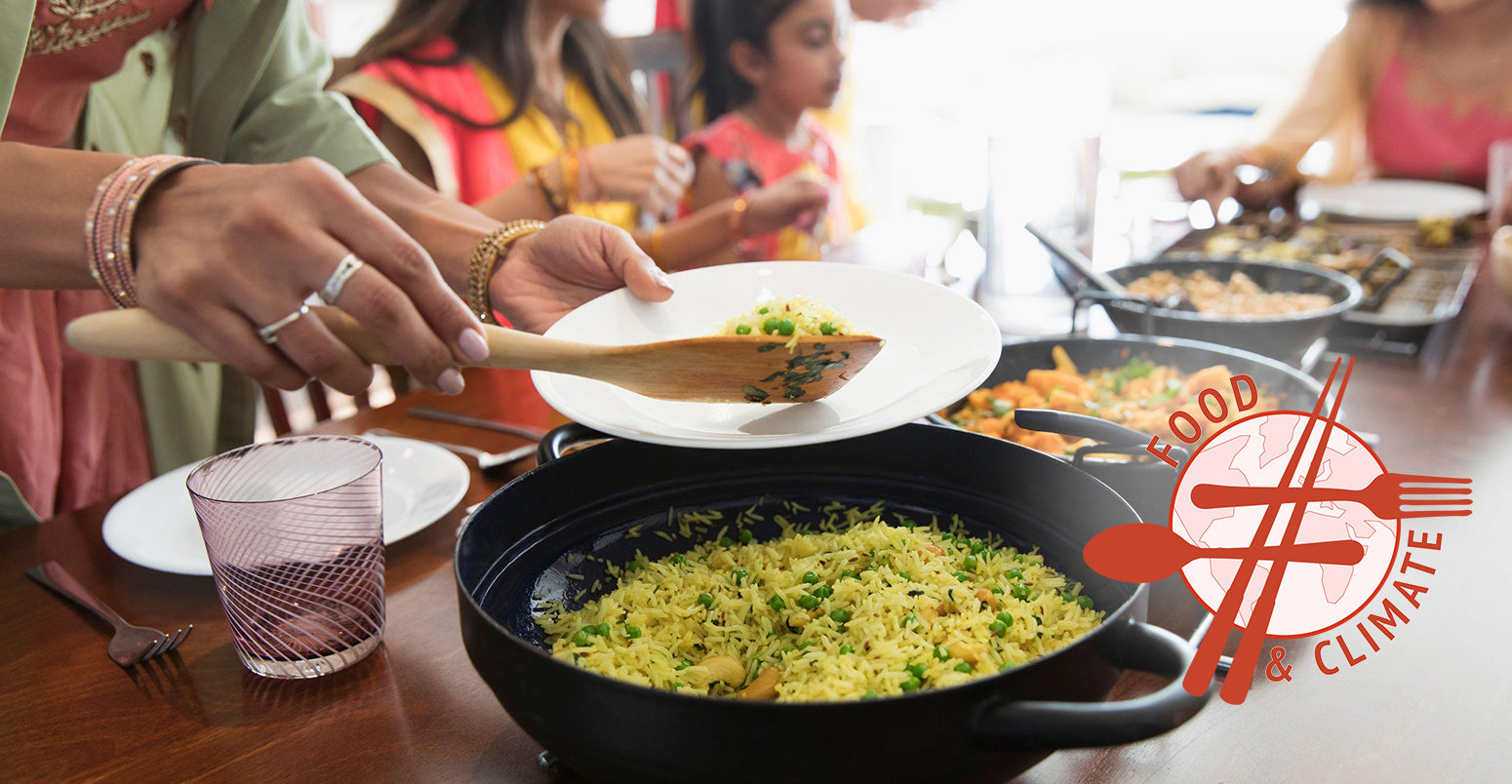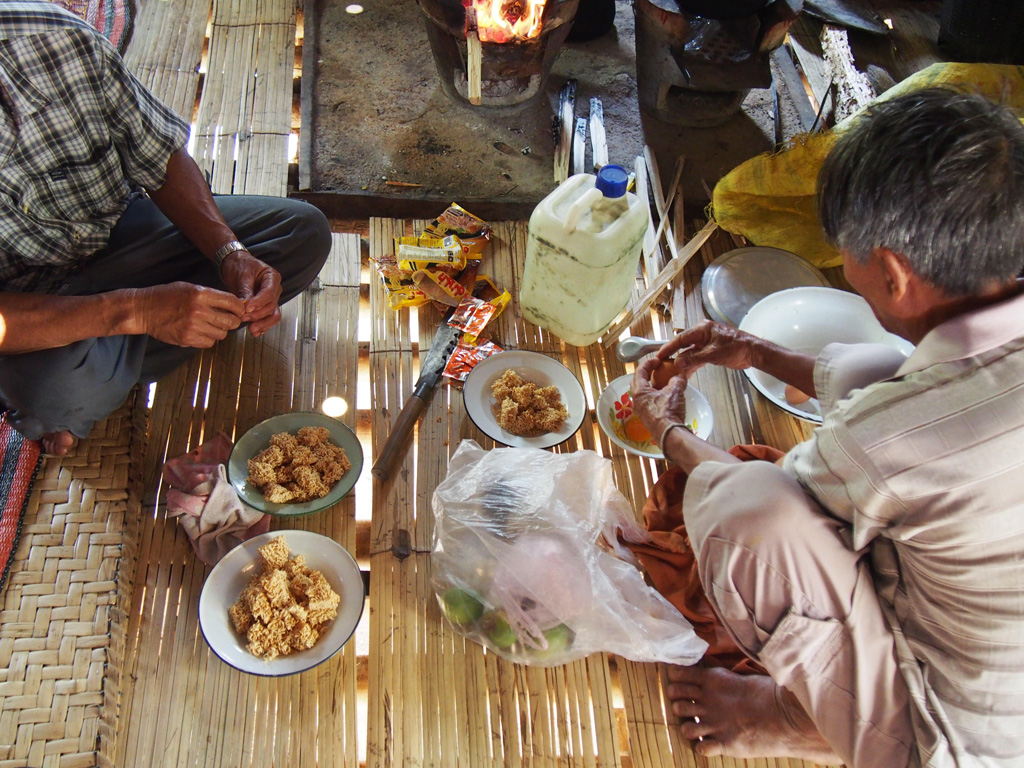
Experts: How do diets need to change to meet climate targets?
Carbon Brief Staff
09.16.20Carbon Brief Staff
16.09.2020 | 7:00amThe food system is a major contributor to climate change and, without significant shifts in global diets, it is unlikely the world will achieve its targets under the Paris Agreement.
It is also a highly complex global system, which makes the task of determining precisely how people’s diets need to change difficult.
Aside from general principles, such as cutting meat and dairy consumption, other issues that need addressing include differences in food production emissions around the world and avoiding food waste.
As part of our week-long series examining food and climate change, Carbon Brief has asked a range of scientists, policy experts and other stakeholders about the role dietary changes will play in limiting global warming.
These are their responses, first as sample quotes, then, below, in full:
- Prof Maggie Gill: “There is no single answer on what you or I should change. It depends on where you live, where and how you buy your food, where it was produced, how it was processed and how far it has travelled.”
- Laura Wellesley: “Long story short: without dietary change, our hopes of averting global temperature rises of 2C or above become very slim indeed.”
- Chris Stark: “A change in diet away from the most carbon-intensive food, such as beef, lamb and dairy, could drive down agricultural emissions.”
- Prof Dave Reay: “Getting it right on food and climate change is not just about the carbon footprint of what is on our plates; for many millions of people it’s about whether there is any food on the plate at all.”
- Brent Kim: “The responsibility for adopting plant-forward diets falls most heavily on high-income countries.”
- Stuart Roberts: “Farmers will produce food to follow market trends and consumer demand. We know that people want to eat nutritious food that has been produced to high environmental and animal welfare standards.”
- Dr Marco Springmann: “Without targeted changes, food-related greenhouse gas emissions could increase by 90% by 2050.”
- Joanna Trewern: “This dietary transition won’t happen without action from businesses and government.”
- Sheril Kirshenbaum: “Changing what we eat can significantly help reach climate targets without requiring new innovation.”
- Dr Hannah Ritchie: “Reducing meat consumption is important, but substituting for lower footprint meats can also make a big difference.”
- Janet Ranganathan: “Limiting ruminant meat consumption…would also nearly eliminate the need for additional agricultural land expansion, helping to feed a growing world population without cutting down more forests.”
- Jen Leung: “On a per-capita basis, Asians consume far less meat than most Western countries…but the magnitude of 1.5 billion Chinese consumers and the rate of growth means curbing consumption trends can make a huge difference.”
- Dr Rosemary Ostfeld: “Eat the food you buy and don’t waste it – food waste is a significant contributor to global greenhouse gas emissions.”
- Prof Sarah Bridle: “We need mandatory accredited labelling of foods to show their environmental impacts.”
- Dr Paul Behrens: “Shifting diets may be an opportunity for exploration rather than abstinence.”
- Dr Amos Tai: “Adopting a diet of ‘mostly plants’ would be not only simply a doctor’s recommendation to their patients, but also one of the most profound paths toward a sustainable planet.”
- Rob Percival: “An organic – or, more broadly, ‘agroecological’ – scenario would require that we eat differently and use our land differently.”
 Prof Maggie Gill
Prof Maggie Gill
Emeritus professor in the School of Biology
University of Aberdeen
This question could be answered at many different scales from global down to individual choices. Food systems are complex with greenhouse gas emissions being produced at all points along the food chain including production, storage, transport, processing, retail and cooking.
- Interactive: What is the climate impact of eating meat and dairy?
- In-depth Q&A: What does the global shift in diets mean for climate change?
- Guest post: Coronavirus food waste comes with huge carbon footprint
- Guest post: Are low- and middle-income countries bound to eat more meat?
- Webinar: Do we need to stop eating meat and dairy to tackle climate change?
Diets are also complex, made up of components from a variety of food chains. Fifty years ago seasons had a major impact on availability, but advances in technology and expansion of trade have led to many products becoming available every month of the year. So there is no single answer on what you or I should change. It depends on where you live, where and how you buy your food, where it was produced, how it was processed and how far it has travelled.
Helping individuals make sense of this complexity for the benefit of meeting climate targets requires a set of principles, rather than oversimplified messages. I offer three here, although I can think of many more.
- Aim to minimise waste, so plan ahead to match the purchase of perishable goods and quantities purchased to healthy household consumption, including healthy portion sizes.
- Match your selection of fruit and vegetables to local seasonal availability, but not to the extent of prejudicing healthy consumption.
- Moderate your consumption of red meat and dairy products, if your current diet is rich in those.
However, overall, perhaps the most important action individuals can take is to work together to pressure the food industry to ensure that environmental sustainability in all aspects of the food chain is a high priority.
 Laura Wellesley
Laura Wellesley
Senior research fellow
Chatham House
If we are to stand a chance of keeping global temperature rise to 1.5C, our diets need to undergo a radical transformation for two reasons.
Firstly, what we eat – and how we grow it – constitutes a major driver of climate change. The global food system is estimated to contribute around 30% of greenhouse gas emissions and more than half of those emissions can be attributed to livestock production. If diets continue along current trajectories, the livestock sector will use up around half of our total 1.5C-consistent carbon budget by 2030 and 37% of a budget consistent with 2C. Switching our diets to lower-emissions alternatives – which, broadly speaking, means moving to more plant-based diets – could go a long way to reducing our overall emissions.
Secondly, we need to limit the amount of land we use to produce our food if hoped-for carbon sequestration strategies are to be feasible. Currently, the most ambitious climate scenarios – those that are in line with the Paris Agreement – assume that bioenergy with carbon capture and storage (BECCS) will be deployed at scale for this purpose. But BECCS on the scale imagined would require an enormous amount of land, equivalent to around half of current global cropland. Other nature-based solutions on the table as climate mitigation strategies include afforestation and reforestation. These again assume that enough land will be made available.
Agriculture uses around one-third of all ice-free land; three-quarters of that agricultural land is taken up with livestock grazing or livestock feed production. Adopting diets that deliver good nutrition for all without transgressing planetary boundaries could significantly reduce the amount of land needed for agriculture, as well as free up land for such sequestration strategies.
Long story short: without dietary change, our hopes of averting global temperature rises of 2C or above become very slim indeed.
 Chris Stark
Chris Stark
Chief executive
Committee on Climate Change
A change in diet away from the most carbon-intensive food, such as beef, lamb and dairy, could drive down agricultural emissions, while freeing up land for other uses to increase carbon sequestration, such as tree planting. Farming currently accounts for more than 70% of land use in the UK.
In its net-zero advice in 2019 – and in an extensive report earlier this year on how the UK can change the use of its land to meet climate targets – the CCC modelled a 20% reduction in UK consumption of beef, lamb and dairy by 2050. Larger reductions in meat consumption would make land-use change even easier.
Some of these changes are already underway. The introduction of plant-based substitutes, such as Beyond Meat, Impossible Burgers and non-dairy milk, have shown there is real potential and appetite for alternatives to beef, lamb and dairy. These products have a much lower emissions footprint than the animal-based originals. It is also important that we avoid imports of higher emission products.

An 100% plant-based Impossible burger served at VeganBurg. Credit: Hugh Mitton / Alamy Stock Photo.
The message here is eat a little less beef, lamb and dairy – and when you do eat it, go for good quality produce from the UK. The UK is one of the least emissions-intensive producers of ruminant meats and dairy products when compared with other countries.
 Prof Dave Reay
Prof Dave Reay
Chair in carbon management and education
University of Edinburgh
Our diets need to get climate-smart. In developed nations this means much less ruminant meat and dairy consumption, allied to big improvements in cutting household food waste. In the UK alone, some 4m tonnes of edible food ends up (pdf) in the bin or down the drain each year – with a climate cost equivalent to around 25m tonnes of CO2 .
Of course, it is not only about emissions. Our food choices can make or break livelihoods. They can lend resilience to what is already a fraying global food system or they can distort and snap its fragile threads.
Embedding sustainability standards and assurance systems into food supply chains – such as is being attempted for cocoa – is vital in helping farmers adapt to climate change, improving productivity and driving down emissions. Getting it right on food and climate change is not just about the carbon footprint of what is on our plates; for many millions of people it’s about whether there is any food on the plate at all.
 Brent Kim
Brent Kim
Programme officer, food production and public health
Johns Hopkins Center for a Livable Future
If global meat and dairy intake continues to rise as projected, greenhouse gas emissions from agriculture alone would very likely surpass 2050 targets.
The EAT-Lancet Commission on healthy diets from sustainable food systems established a target of 5bn tonnes of CO2 equivalent from food systems by 2050. The target assumes CO2 emissions will reach zero by 2050 and, thus, applies only to methane and nitrous oxide (N2O) emissions. The commission recommends a healthy, plant-forward diet, high in wholegrains, legumes, vegetables, fruits and healthy fats with a very modest amount of animal protein – about 300 calories worth, or only 12% of the recommended 2,500 calories.
The responsibility for adopting plant-forward diets falls most heavily on high-income countries, such the US, which currently consume the highest amounts of animal products. Dietary patterns can only be considered “sustainable” if they meet nutrition as well as ecological goals and many low- and middle-income countries will likely need to increase their intake of animal foods to address the high prevalence of malnutrition. Offsetting the associated increase in emissions will require high-income countries to reduce animal product intake even further.
Fortunately, there are many flexible options. As the EAT-Lancet Commission suggests, there is room on sustainable menus for a modest amount of animal protein. For example, my colleagues and I at the Johns Hopkins Center for a Livable Future proposed a “low food chain” diet that is mostly plant-based with some climate-friendly animal proteins, such as small fish, bivalve molluscs and edible insects.
 Stuart Roberts
Stuart Roberts
Deputy president
UK National Farmers Union
When it comes to diets, it’s up to no one but the individual to dictate what they should and shouldn’t eat. People need to make the decision based on what is right for them, and be confident that whatever diet they adopt they can make decisions within that to lower their carbon footprint.
One of the best ways to do this is to consider where and how a product has been produced. Beef is the obvious example. You can eat beef from Brazil where the Amazon is being cut down to make room for cattle and the crops that feed them, or you can eat UK beef which is reared on a grass-based diet, contributes to vast stores of carbon in grassland and where emissions are half the global average. [For more on grass-fed beef, see Carbon Brief’s coverage of a report in 2017 that found it is still a net contributor to climate change.]
It’s the same with all products – you can get avocados, soya and almonds that have been produced with minimal climate impact, and you can get avocados, soya and almonds that have been produced in some of the most unsustainable systems around. It is all about the where and the how.
Ultimately, farmers will produce food to follow market trends and consumer demand. We know that people want to eat nutritious food that has been produced to high environmental and animal welfare standards, and that’s the benchmark British farmers set themselves every day.
 Dr Marco Springmann
Dr Marco Springmann
Senior researcher in population health
Oxford Martin Programme on the Future of Food
We estimated that without targeted changes, food-related greenhouse gas emissions could increase by 90% by 2050.
But how much do diets need to change to meet climate targets? An international team of 36 researchers and I attempted to provide an answer to that question in the EAT-Lancet Commission on Healthy Diets from Sustainable Food Systems. We developed recommendations for planetary health diets that are healthy, nutritionally balanced and, when paired with other food-system changes, just about meet the food-related climate target and other environmental goals, including for land and water use and fertiliser application. [For details of this diet, see Carbon Brief’s interactive explainer.}
Of course, there is some flexibility to these broad recommendations, but we found that, for example, doubling the amount of red meat or dairy [from proposed levels] increased emissions far above the limit. The upshot of this and other research is: climate-friendly diets are predominantly plant-based.
 Joanna Trewern
Joanna Trewern
Sustainable diets and behaviour change specialist
WWF UK
In higher income countries, such as the UK, we need to rebalance our diets and change our relationship with protein – 60% of the protein consumed by the average UK citizen comes from animal sources and only 20% of us eat enough vegetables.
Our Livewell dietary analysis demonstrated that making small changes to existing diets, including eating more plants, grains and legumes, could help cut greenhouse gas emissions by 30% by 2030, while still meeting nutritional requirements set out in the UK government’s Eatwell Guide. We produced recommendations for adults, adolescents, the elderly and vegans, recognising their different dietary requirements.
This dietary transition won’t happen without action from businesses and government, who need to demonstrate leadership and create the enabling environment for change that supports and incentivises consumers, businesses and food producers to alter their behaviours and practices.
 Sheril Kirshenbaum
Sheril Kirshenbaum
Associate research scientist in Food@MSU
Michigan State University
Changing what we eat can significantly help reach climate targets without requiring new innovation. While we cannot expect everyone to adopt a vegetarian lifestyle, broadly transitioning to more plant-based diets would meaningfully reduce emissions while saving important resources like water and energy.
The new generation of plant-based meats have been engineered to taste, smell and even bleed like the real thing – without using the land, energy and water required for raising farm animals. Our national surveys at Michigan State University suggest millenials and Gen Z are already embracing these plant-based alternatives, while major food chains and grocery stores are making them increasingly available. Likewise, cell-cultured meat, which doesn’t involve livestock and avoids the associated environmental impacts, is poised to further decrease global dependence on traditionally raised beef, poultry and seafood.
As we become increasingly thoughtful about our purchases at the grocery store, more informed about unnecessary sell-by dates and conscious of our personal and collective “foodprint,” we have a real opportunity to inch ever closer toward climate targets.
 Dr Hannah Ritchie
Dr Hannah Ritchie
Head of research
Our World In Data;University of Oxford
Food is often framed as the mother of sustainability issues: not only for its impacts on climate change, but also as the largest user of land and as a driver of deforestation, water use, pollution of water systems and biodiversity loss. Combine that with its socioeconomic role – for health, nutrition, livelihoods and culture – and we’re left with a really complex challenge.
With such complexity there is no “one size fits all” solution. Not only are “all or nothing” approaches sometimes ill-suited to the local context, they are also very socially divisive. Reducing meat consumption is important, but substituting for lower footprint meats can also make a big difference: chicken, eggs and fish tend to have a lower climate impact.
Dietary changes alone will not be enough. Even if we all ate close to the recommended guidelines, we’d eat up our carbon budget without large improvements on the producer side. We need to continue improving crop yields, nutrient efficiency, pasture management and livestock productivity. There the solutions are very much dependent on the local context.
 Janet Ranganathan
Janet Ranganathan
Vice president for research, data, and innovation
World Resources Institute
In the US, ruminant meat (mostly beef) supplies only 3% of calories and 12% of protein, while contributing to roughly half the average person’s diet-related greenhouse gas emissions. If cattle were to form their own nation, they would be the third largest emitter behind China and the US. They’d also be one of the fast-growing nations. Ruminant meat demand is projected to grow by 88% between 2010 and 2050.
Limiting ruminant meat consumption to about 1.5 hamburgers per person per week would cut in half the agriculture sector’s 11bn tonne of CO2e mitigation gap (the difference between expected agricultural emissions in 2050 and the target level needed to hold global warming below 2C). It would also nearly eliminate the need for additional agricultural land expansion, helping to feed a growing world population without cutting down more forests.
Shifts in diets are already underway. Companies such as Hilton, IKEA and Max Burgers have signed a Cool Food Pledge to collectively reduce emissions associated with the food they provide by 25% by 2030 relative to 2015 – a level of ambition in line with keeping global warming below 1.5C.
 Jen Leung
Jen Leung
Climate programme director
WildAid
In climate advocacy, only more recently have people begun to focus on the impact of diets on the climate crisis and the tremendous environmental cost of eating meat and dairy in particular.
At WildAid, we’re aiming to shift demand towards more sustainable, climate-friendly diets that not only mitigate climate change by lowering emissions, but also reduce deforestation and the drain on natural resources caused by meat production. We work at a global level, but see great potential in kick starting the sea change needed to shift the world towards a planet-friendly diet by working in Asia.

On a per-capita basis, Asians consume far less meat than most Western countries. Credit: EyeEm / Alamy Stock Photo.
Asia is currently responsible for 45% of global meat consumption. Meat and seafood consumption is set to rise by almost 80% by 2050, spurred by rising wealth and a growing middle class. On a per-capita basis, Asians consume far less meat than most Western countries – for example, China consumes about half the amount as Americans – but the magnitude of 1.5 billion Chinese consumers and the rate of growth means curbing consumption trends can make a huge difference on a global scale.
Also, traditionally Asian diets have a much healthier balance of plant-based versus meat dishes, so not only can we emphasise the benefits of eating sustainably, we can do this by celebrating traditional cuisines and cultures.
 Dr Rosemary Ostfeld
Dr Rosemary Ostfeld
Interdisciplinary environmental scientist
Wesleyan University
There are a few simple things people can consider at their next meal:
- Eat food that is grown using inputs that have a low climate-impact. When synthetic nitrogen-based fertilisers are used to grow crops, this results in N2O emissions – so consider eating food that is grown organically without the application of synthetic fertilisers.
- Eat fruits and vegetables that are in-season and grown locally. A significant amount of fresh fruits and vegetables are imported into the US and UK and some highly perishable foods may need to be transported by air to make it to your plate without spoiling.
Finally, eat the food you buy and don’t waste it – food waste is a significant contributor to global greenhouse gas emissions.
 Prof Sarah Bridle
Prof Sarah Bridle
Founder
Science and Technology Facilities Council (STFC) Food Network+
When I started out in my transition from astrophysics research to food and climate change, I wanted to know “the climate impact of eggs” or “the climate impact of nuts”. I realise now that only a relative newcomer would have the audacity to ask such simplistic questions. Many studies have found that there is a wide range of climate impacts from producers of each single type of food. We need to embrace the fact that different food production practices cause different climate impacts.
Maybe as a data geek I’m biased, but I’ve concluded the only way out of this potential deadlock is transparency and data. We need mandatory accredited labelling of foods to show their environmental impacts.
Only with this information can we all get on the same side of the table and have rational discussions about how to transform the food system and make informed decisions about how to change what we eat. The consumer is empowered but, most importantly of all, the food producer is involved in the process and has the opportunity to make significant improvements. And, if that isn’t enough, climate impact labelling is a necessary first step towards financial incentivisation.
 Dr Paul Behrens
Dr Paul Behrens
Assistant professor of environment and climate change
Leiden University
Shifting diets may be an opportunity for exploration rather than abstinence. One study found that, as more interesting plant-based foods become available, meat eaters choose more plant-based foods. This will hopefully be a virtuous feedback with markets responding to changes in individual diets and individual diets responding to what is available in the shops.
As with fossil fuel subsidies, a reform in agricultural subsidies is desperately needed to ensure these options don’t seem artificially expensive. We have only scratched the surface of what is possible in new plant-based foods. The question remains: how fast can we change – and will it be quickly enough to curb worst-case scenarios?
 Dr Amos Tai
Dr Amos Tai
Associate professor in the earth system science programme
The Chinese University of Hong Kong
Modifying the current food system is an essential part of the integral solutions for combating climate change. Sustainable farming methods such as intercropping and crop rotation have been proven to have high mitigation potentials.
- Interactive: How climate change could threaten the world’s traditional dishes
- Interactive: How climate change shapes food insecurity across the world
- Meat and dairy consumption could mean a two-degree target is “off the table”
- Grass-fed beef will not help tackle climate change, report finds
- Farming overtakes deforestation and land use as a driver of climate change
City-dwellers, however, may think that their contribution in this regard is limited – after all, most of them aren’t involved in the food production sector. That is far from being true. We all eat food, and our food demand is the ultimate driver for food production.
I shall borrow the three food mottos proposed by renowned science writer, Michael Pollan, namely: “Eat food. Not too much. Mostly plants.”
Pollan originally wrote his recommendations mostly for readers concerned with personal health, but they may very well apply to planetary health too. “Eat food” means to eat real, unprocessed and mostly local food. A conscious reduction of daily food consumption can reduce not only health risks but also food demand and waste, rendering production more efficient and less greenhouse gas-emitting.
City-dwellers generally have higher meat and dairy consumption than rural populations. Hong Kong – where I’m from – is a notorious case; about 40% of our daily calorie intake is derived from meat, egg and dairy products. Adopting a diet of “mostly plants” would be not only simply a doctor’s recommendation to their patients, but also one of the most profound paths toward a sustainable planet with a stable climate.
 Rob Percival
Rob Percival
Head of food policy
Soil Association
Because they avoid artificial fertilisers, protect soils and use less energy, organic farms are helping to mitigate climate change. If Europe’s farmland all followed organic principles, agricultural emissions could drop by 40-50% by 2050.
Organic farming nourishes plants naturally by building fertile soils, using leguminous plants to fix nitrogen, as well as using compost, animal manure and green manures, and crop rotations. This process is fuelled by the sun, whereas the manufacture of synthetic nitrogen fertilisers relies on fossil fuels. Fertiliser manufacture consumes between 3% and 5% of the world’s natural gas, and fertiliser application contributes to the release of nitrous oxide.
Soil is one of our most important tools in the fight against climate change and organic soils typically sequester and store more carbon. Cows – as we are told so often – burp methane, but in organic systems they make a vital contribution to healthy soils, nutrient cycling and landscape management.
An organic – or, more broadly, “agroecological” – scenario would require that we eat differently and use our land differently. Our diets would be richer in plants and plant proteins, and would include far fewer ultra-processed foods. We would be eating much less pork and poultry – and less meat overall – having phased out intensive livestock production. But meat from ruminant animals would remain an integral – if reduced – part of our diets.
-
Experts: How do diets need to change to meet climate targets?
-
In-depth: Experts discuss how diets need to change to tackle climate change

